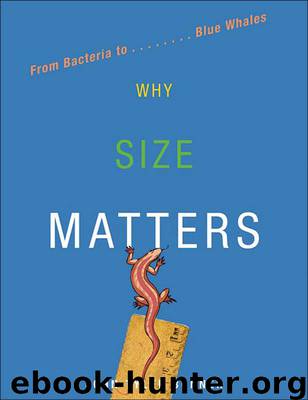Why Size Matters by Bonner John Tyler

Author:Bonner, John Tyler
Language: eng
Format: epub
Publisher: Princeton University Press
Published: 2006-03-26T16:00:00+00:00
CHAPTER 5
SIZE AND THE DIVISION OF LABOR
For many years I have been struggling to understand the relation between size and the division of labor in multicellular organisms. One wants to know why it is generally true that the bigger the organism, the greater the division of labor. It is a principle that to some degree we all accept as given; let us examine it closely.
The division of labor, which is a reflection of biological complexity, is a venerable subject. The history of the idea has a few years ago been admirably discussed by Camille Limoges.16 He points out that the pioneer for considering the matter within organisms goes back to Henri Milne-Edwards, who as early as 1827 said that animals had a “division of physiological labor.” Limoges goes on to say that Darwin was favorably impressed by the writings of Milne-Edwards, who in turn influenced the pioneer in sociology, Emile Durkheim. The conclusion of Limoges is that there has always been a close association between the concept of division of labor as it applies to individual organisms and as it applies to societies (a matter to which I will return). However, none of these earlier authors were particularly interested in size as a significant correlate. This tradition continues to this day, and the matter of size is not central to our current thinking. What I wish to show here is that significant increases or decreases in size during the course of evolution are accompanied by increases or decreases in the division of labor.
We now come to another of our basic size rules. The rules discussed so far are the relation between (1) size and strength, along with (2) size and surface areas. There is a similar relation between size and complexity. Like the others, it also can be expressed as an allometric relation:
(3) Complexity ∝ Weighta.
As we proceed from the strength-size rule, and particularly to the surface-size rule, there is a direct trend towards the complexity-size rule. As I pointed out before, in a larger aerobic animal it is imperative to get oxygen to the internal tissues. To do this it is necessary to produce a circulatory system with a pumping heart, innumerable capillaries, and lungs or gills with huge surfaces to trap the oxygen that is then carried by the red blood cells to the tissues. Plainly, as size increases the demands of the surface-size rule has dictated an enormous increase in complexity. The three rules are indeed connected to one another and they are all directly related to changes in size.
A convenient way to measure biological complexity is to think of it in terms of the number of cell types. A mammal will have a large number of distinct cell types, such as muscle cells, liver cells, brain cells, blood cells, and so forth. A parallel kind of list can be made for all other organisms, including plants. The number of cell types can be considered a rough reflection of the division of labor, or complexity; it is a useful indicator.
Download
This site does not store any files on its server. We only index and link to content provided by other sites. Please contact the content providers to delete copyright contents if any and email us, we'll remove relevant links or contents immediately.
| Anatomy | Animals |
| Bacteriology | Biochemistry |
| Bioelectricity | Bioinformatics |
| Biology | Biophysics |
| Biotechnology | Botany |
| Ecology | Genetics |
| Paleontology | Plants |
| Taxonomic Classification | Zoology |
Sapiens: A Brief History of Humankind by Yuval Noah Harari(14245)
The Tidewater Tales by John Barth(12608)
Mastermind: How to Think Like Sherlock Holmes by Maria Konnikova(7223)
Do No Harm Stories of Life, Death and Brain Surgery by Henry Marsh(6887)
The Thirst by Nesbo Jo(6826)
Why We Sleep: Unlocking the Power of Sleep and Dreams by Matthew Walker(6618)
Life 3.0: Being Human in the Age of Artificial Intelligence by Tegmark Max(5474)
Sapiens by Yuval Noah Harari(5293)
The Longevity Diet by Valter Longo(5017)
The Body: A Guide for Occupants by Bill Bryson(4973)
The Rules Do Not Apply by Ariel Levy(4844)
The Immortal Life of Henrietta Lacks by Rebecca Skloot(4524)
Animal Frequency by Melissa Alvarez(4394)
Why We Sleep by Matthew Walker(4358)
The Hacking of the American Mind by Robert H. Lustig(4318)
Yoga Anatomy by Kaminoff Leslie(4303)
All Creatures Great and Small by James Herriot(4230)
Double Down (Diary of a Wimpy Kid Book 11) by Jeff Kinney(4204)
Barron's AP Biology by Goldberg M.S. Deborah T(4095)
